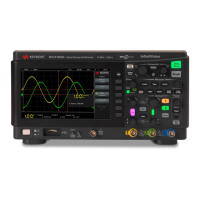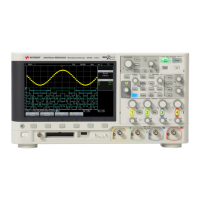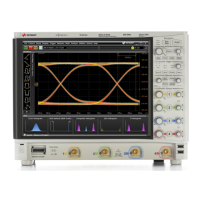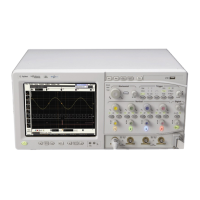Math Waveforms 5
Keysight InfiniiVision HD3-Series Oscilloscopes User's Guide 89
The source of the FFT math functions can be analog input channels or a lower
math function.
The horizontal axis of FFT math functions is frequency (Hertz). For the FFT
(Magnitude) math function, the vertical axis is in decibels when Logarithmic vertical
units are selected or V RMS when Linear vertical units are selected. For the FFT
(Phase) math function, the vertical axis is in degrees or radians.
Use the FFT (Magnitude) function to find crosstalk problems, to find distortion
problems in analog waveforms caused by amplifier non-linearity, or for adjusting
analog filters.
When the FFT (Magnitude) or FFT (Phase) operators are selected, the Waveform Math
dialog box has these additional controls:
• Input — Selects how the displayed frequency range is entered:
• Center/Span — Span specifies the frequency range represented by the width
of the display. Divide span by 10 to calculate the frequency scale per
division. Center specifies the frequency at the center vertical grid line of the
display.
• Start/Stop — Start Freq specifies the frequency at the left side of the display.
Stop Freq specifies the frequency at the right side of the display.
• Zero Phase Ref — When the FFT (Phase) operator is selected, this control sets the
reference point for calculating the FFT Phase function:
• Trigger — the FFT phase is measured from the trigger (time=0) point of the
waveform.
• Entire Display — the FFT phase is measured from the beginning of the
displayed waveform.
• Readout — Specifies how the FFT resolution is displayed: Off, Sample Rate, Bin
Size, RBW (Resolution Bandwidth).
• Auto Setup — Sets the frequency Span and Center to values that will cause the
entire available spectrum to be displayed. The maximum available frequency is
half the FFT sample rate, which is a function of the time per division setting.
The FFT resolution is the quotient of the sampling rate and the number of FFT
points (f
S
/N). The current FFT Resolution is displayed on screen.
• Add Max Function — Adds another math function waveform that is the Max Hold
operator on the FFT math function waveform.
• Advanced FFT... — Opens the Advanced FFT dialog box where you can select a
window, specify vertical units, select gating, or set up detectors.
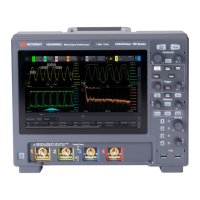
